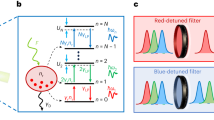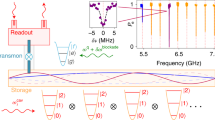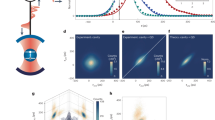Abstract
Decay of a particle into more particles is a ubiquitous phenomenon to interacting quantum systems, taking place in colliders, nuclear reactors or solids. In a nonlinear medium, even a single photon would decay by down-converting (splitting) into lower-frequency photons with the same total energy1, at a rate given by Fermi’s golden rule. However, the energy-conservation condition cannot be matched precisely if the medium is finite and only supports quantized modes. In this case, the fate of the photon becomes the long-standing question of many-body localization, originally formulated as a gedanken experiment for the lifetime of a single Fermi-liquid quasiparticle confined to a quantum dot2. Here we implement such an experiment using a superconducting multimode cavity, the nonlinearity of which was tailored to strongly violate the photon-number conservation. The resulting interaction attempts to convert a single photon excitation into a shower of low-energy photons but fails owing to the many-body localization mechanism, which manifests as a striking spectral fine structure of multiparticle resonances at the standing-wave-mode frequencies of the cavity. Each resonance was identified as a many-body state of radiation composed of photons from a broad frequency range and not obeying Fermi’s golden rule theory. Our result introduces a new platform to explore the fundamentals of many-body localization without having to control many atoms or qubits3,4,5,6,7,8,9.
This is a preview of subscription content, access via your institution
Access options
Access Nature and 54 other Nature Portfolio journals
Get Nature+, our best-value online-access subscription
$29.99 / 30 days
cancel any time
Subscribe to this journal
Receive 51 print issues and online access
$199.00 per year
only $3.90 per issue
Buy this article
- Purchase on Springer Link
- Instant access to full article PDF
Prices may be subject to local taxes which are calculated during checkout




Similar content being viewed by others
Data availability
The raw data collected in this study are available from the corresponding author on reasonable request.
Code availability
The code used to analyse the data reported in this study is available from the corresponding author on reasonable request.
References
Klyshko, D. Scattering of light in a medium with nonlinear polarizability. Sov. Phys. JETP 28, 522–526 (1969).
Altshuler, B. L., Gefen, Y., Kamenev, A. & Levitov, L. S. Quasiparticle lifetime in a finite system: a nonperturbative approach. Phys. Rev. Lett. 78, 2803–2806 (1997).
Schreiber, M. et al. Observation of many-body localization of interacting fermions in a quasirandom optical lattice. Science 349, 842–845 (2015).
Smith, J. et al. Many-body localization in a quantum simulator with programmable random disorder. Nat. Phys. 12, 907–911 (2016).
Roushan, P. et al. Spectroscopic signatures of localization with interacting photons in superconducting qubits. Science 358, 1175–1179 (2017).
Lukin, A. et al. Probing entanglement in a many-body–localized system. Science 364, 256–260 (2019).
Bluvstein, D. et al. Controlling quantum many-body dynamics in driven Rydberg atom arrays. Science 371, 1355–1359 (2021).
Morong, W. et al. Observation of Stark many-body localization without disorder. Nature 599, 393–398 (2021).
Guo, Q. et al. Observation of energy-resolved many-body localization. Nat. Phys. 17, 234–239 (2021).
Anderson, P. W. Absence of diffusion in certain random lattices. Phys. Rev. 109, 1492–1505 (1958).
Gornyi, I. V., Mirlin, A. D. & Polyakov, D. G. Interacting electrons in disordered wires: Anderson localization and low-t transport. Phys. Rev. Lett. 95, 206603 (2005).
Basko, D., Aleiner, I. & Altshuler, B. Metal–insulator transition in a weakly interacting many-electron system with localized single-particle states. Ann. Phys. 321, 1126–1205 (2006).
Basko, D. M., Aleiner, I. L. & Altshuler, B. L. Possible experimental manifestations of the many-body localization. Phys. Rev. B 76, 052203 (2007).
Oganesyan, V. & Huse, D. A. Localization of interacting fermions at high temperature. Phys. Rev. B 75, 155111 (2007).
Serbyn, M., Papić, Z. & Abanin, D. A. Local conservation laws and the structure of the many-body localized states. Phys. Rev. Lett. 111, 127201 (2013).
Huse, D. A., Nandkishore, R. & Oganesyan, V. Phenomenology of fully many-body-localized systems. Phys. Rev. B 90, 174202 (2014).
Nandkishore, R. & Huse, D. A. Many-body localization and thermalization in quantum statistical mechanics. Annu. Rev. Condens. Matter Phys. 6, 15–38 (2015).
Abanin, D. A., Altman, E., Bloch, I. & Serbyn, M. Colloquium: Many-body localization, thermalization, and entanglement. Rev. Mod. Phys. 91, 021001 (2019).
Choi, J.-Y. et al. Exploring the many-body localization transition in two dimensions. Science 352, 1547–1552 (2016).
Xu, K. et al. Emulating many-body localization with a superconducting quantum processor. Phys. Rev. Lett. 120, 050507 (2018).
Mirlin, A. D. Statistics of energy levels and eigenfunctions in disordered systems. Phys. Rep. 326, 259–382 (2000).
Serbyn, M. & Moore, J. E. Spectral statistics across the many-body localization transition. Phys. Rev. B 93, 041424 (2016).
Nandkishore, R., Gopalakrishnan, S. & Huse, D. A. Spectral features of a many-body-localized system weakly coupled to a bath. Phys. Rev. B 90, 064203 (2014).
Johri, S., Nandkishore, R. & Bhatt, R. N. Many-body localization in imperfectly isolated quantum systems. Phys. Rev. Lett. 114, 117401 (2015).
Folk, J., Marcus, C. & Harris, J.Jr Decoherence in nearly isolated quantum dots. Phys. Rev. Lett. 87, 206802 (2001).
Manucharyan, V. E., Koch, J., Glazman, L. I. & Devoret, M. H. Fluxonium: single Cooper-pair circuit free of charge offsets. Science 326, 113–116 (2009).
Meiser, D. & Meystre, P. Superstrong coupling regime of cavity quantum electrodynamics. Phys. Rev. A 74, 065801 (2006).
Sundaresan, N. M. et al. Beyond strong coupling in a multimode cavity. Phys. Rev. X 5, 021035 (2015).
Martínez, J. P. et al. A tunable Josephson platform to explore many-body quantum optics in circuit-QED. npj Quantum Inf. 5, 19 (2019).
Kuzmin, R., Mehta, N., Grabon, N., Mencia, R. & Manucharyan, V. Superstrong coupling in circuit quantum electrodynamics. npj Quantum Inf. 5, 20 (2019).
Mehta, N., Ciuti, C., Kuzmin, R. & Manucharyan, V. E. Theory of strong down-conversion in multi-mode cavity and circuit QED. Preprint at https://arxiv.org/abs/2210.14681 (2022).
Kuzmin, R. et al. Quantum electrodynamics of a superconductor–insulator phase transition. Nat. Phys. 15, 930–934 (2019).
Nigg, S. E. et al. Black-box superconducting circuit quantization. Phys. Rev. Lett. 108, 240502 (2012).
Kuzmin, R. et al. Inelastic scattering of a photon by a quantum phase slip. Phys. Rev. Lett. 126, 197701 (2021).
Kuzmin, R., Mehta, N., Grabon, N. & Manucharyan, V. E. Tuning the inductance of Josephson junction arrays without SQUIDs. Preprint at https://arxiv.org/abs/2210.12119 (2022).
Naik, R. et al. Random access quantum information processors using multimode circuit quantum electrodynamics. Nat. Commun. 8, 1904 (2017).
Acknowledgements
We acknowledge support from DOE Early Career Award (DE-SC0020160), US ARO MURI programme ‘Exotic states of light in superconducting circuits’ (W911NF-15-1-0397) and Google Faculty Research Award. C.C. acknowledges financial support from FET FLAGSHIP Project PhoQuS (grant agreement no. 820392) and from the French agency ANR through the project NOMOS (ANR-18-CE24-0026) and TRIANGLE (ANR-20-CE47-0011).
Author information
Authors and Affiliations
Contributions
R.K. built the experimental setup and, assisted by N.M., performed the measurements. N.M. fabricated the device and performed data analysis, guided by C.C. and V.E.M. All authors contributed to extensive discussions of the data and writing of the manuscript. V.E.M. managed the project.
Corresponding author
Ethics declarations
Competing interests
The authors declare no competing interests.
Peer review
Peer review information
Nature thanks Rahul Nandkishore and the other, anonymous, reviewer(s) for their contribution to the peer review of this work.
Additional information
Publisher’s note Springer Nature remains neutral with regard to jurisdictional claims in published maps and institutional affiliations.
Extended data figures and tables
Extended Data Fig. 1 Non-interacting spectra.
Left column, excitation frequency versus the applied flux bias for the single-particle eigenstates (solid black lines). The filled black dots are the experimental data used for the fitting procedure described in the text. Middle column, energy of the uncoupled two-particle states added (red lines). Right column, energy of the uncoupled thee-particle states added (green lines). Note that at a frequency of around 8 GHz and above, the three-particle spectrum is almost uniformly spread in energy, as if the system has a natural disorder in the single-particle spectrum.
Extended Data Fig. 2 Dispersion characterization.
Measured standing-wave-mode frequency spacing fk+1 − fk versus frequency fk (k = 1, 2,…) at φext = 0 (black circles) and at φext/2π = 0.5 (red circles). The dispersion varies the mode spacing from 165 to 195 MHz in the frequency range of interest. The non-dispersive mode spacing is extracted to be Δ = v/2ℓ ≈ 197 MHz. The hybridization window width Γ ≈ 1 GHz and the low-frequency cutoff corresponding to j0 = 20 are indicated.
Extended Data Fig. 3 Interaction parameters.
a, Photon–photon interaction frequency scale g as a function of the external flux. b, Colour plot of the matrix elements Ak,k′ versus the mode indices k,k′ when the qubit frequency is tuned to feg = 7.2 GHz (around mode index 39) at φext/2π = 0.36. Note that the width of the local maximum in Ak,k′ is given by Γ/Δ.
Extended Data Fig. 4 Photon loss characterization.
Internal (blue circles) and external (red triangles) quality factors of the bare Fabry–Pérot modes as a function of mode frequency measured at the flux bias φext = 0. For this flux value, the qubit coupling is negligible.
Rights and permissions
Springer Nature or its licensor (e.g. a society or other partner) holds exclusive rights to this article under a publishing agreement with the author(s) or other rightsholder(s); author self-archiving of the accepted manuscript version of this article is solely governed by the terms of such publishing agreement and applicable law.
About this article
Cite this article
Mehta, N., Kuzmin, R., Ciuti, C. et al. Down-conversion of a single photon as a probe of many-body localization. Nature 613, 650–655 (2023). https://doi.org/10.1038/s41586-022-05615-y
Received:
Accepted:
Published:
Issue Date:
DOI: https://doi.org/10.1038/s41586-022-05615-y
This article is cited by
Comments
By submitting a comment you agree to abide by our Terms and Community Guidelines. If you find something abusive or that does not comply with our terms or guidelines please flag it as inappropriate.



